从Nida的读者同等反应论看商标的翻译
- 格式:pdf
- 大小:74.43 KB
- 文档页数:2
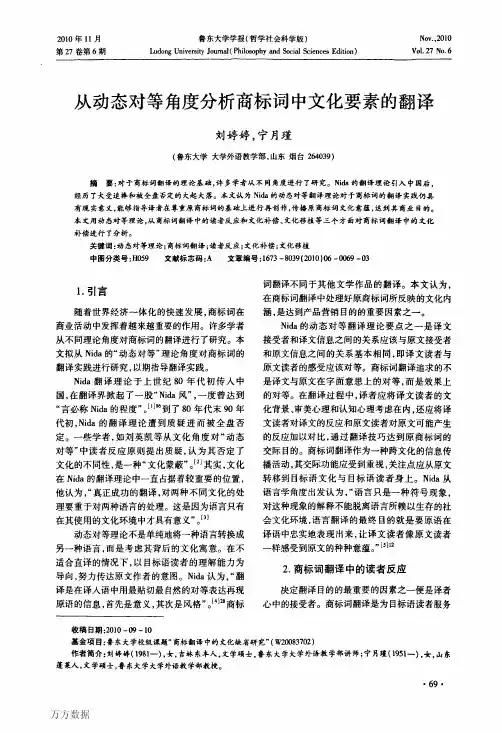

尤金奈达的对等理论文不灭质,博不溺心尤金·奈达(EugeneAlbertNida,1914—2011),美国当代著名翻译理论家,主要从事《圣经》的翻译和修订。
他是当代整个西方翻译理论界最具影响力的人物之一,在中国产生的影响也是有目共睹。
尤金在40岁时出版的《翻译科学探索》一书中提出了“动态对等”的概念。
所谓“动态对等”是指“译文读者对译文作出的反应与原文读者反应一致”,他为了避免理解动态对等就是强调形式上的一致,于是用“功能对等(Nida,EugeneA。
&CharlesTaberR。
1969)”替换了“动态对等”。
功能对等理论主要通过以下四个标准来指导翻译实践:(1)传达原文信息;(2)传达原作的精神和风格;(3)语言通顺、易懂;(4)目的语与源语读者反应相似。
奈达认为,译者应尽可能做到自然、切近的对等,翻译最重要的是读者对译文的反应。
功能对等包括四个方面:词汇对等、句法对等、篇章对等和文体对等。
功能对等强调翻译的读者和原文的读者反应一致。
在翻譯文本时,除了达意外,还应具有国家文化、文章情境、时代背景等深层对等。
奈达认为,译者应该始终预测目标语言接收者的理解程度和回应效果,当目标语言接收者对翻译的回应与源语言接收者对原文的回应一致时,就达到了最佳翻译效果。
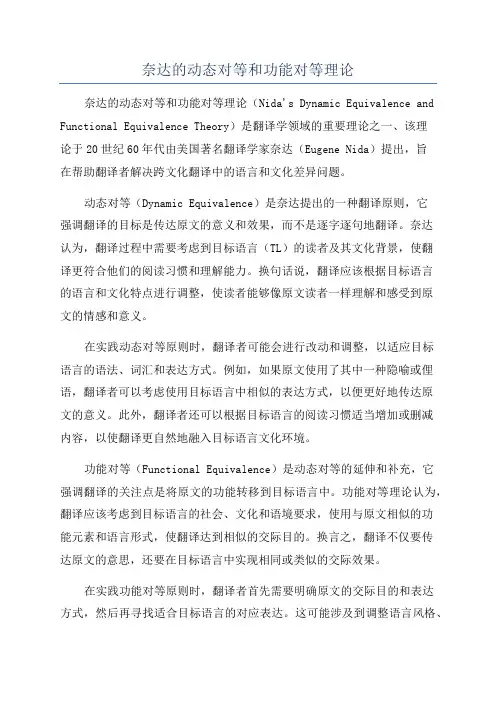
奈达的动态对等和功能对等理论奈达的动态对等和功能对等理论(Nida's Dynamic Equivalence and Functional Equivalence Theory)是翻译学领域的重要理论之一、该理论于20世纪60年代由美国著名翻译学家奈达(Eugene Nida)提出,旨在帮助翻译者解决跨文化翻译中的语言和文化差异问题。
动态对等(Dynamic Equivalence)是奈达提出的一种翻译原则,它强调翻译的目标是传达原文的意义和效果,而不是逐字逐句地翻译。
奈达认为,翻译过程中需要考虑到目标语言(TL)的读者及其文化背景,使翻译更符合他们的阅读习惯和理解能力。
换句话说,翻译应该根据目标语言的语言和文化特点进行调整,使读者能够像原文读者一样理解和感受到原文的情感和意义。
在实践动态对等原则时,翻译者可能会进行改动和调整,以适应目标语言的语法、词汇和表达方式。
例如,如果原文使用了其中一种隐喻或俚语,翻译者可以考虑使用目标语言中相似的表达方式,以便更好地传达原文的意义。
此外,翻译者还可以根据目标语言的阅读习惯适当增加或删减内容,以使翻译更自然地融入目标语言文化环境。
功能对等(Functional Equivalence)是动态对等的延伸和补充,它强调翻译的关注点是将原文的功能转移到目标语言中。
功能对等理论认为,翻译应该考虑到目标语言的社会、文化和语境要求,使用与原文相似的功能元素和语言形式,使翻译达到相似的交际目的。
换言之,翻译不仅要传达原文的意思,还要在目标语言中实现相同或类似的交际效果。
在实践功能对等原则时,翻译者首先需要明确原文的交际目的和表达方式,然后再寻找适合目标语言的对应表达。
这可能涉及到调整语言风格、选择特定的词汇、调整语气和情感色彩等。
通过运用功能对等原则,翻译者可以更好地满足目标语言读者的交际需求,使翻译更具说服力和可接受性。
总的来说,奈达的动态对等和功能对等理论提供了一种方法和原则,帮助翻译者解决从原文语言到目标语言的转换问题。

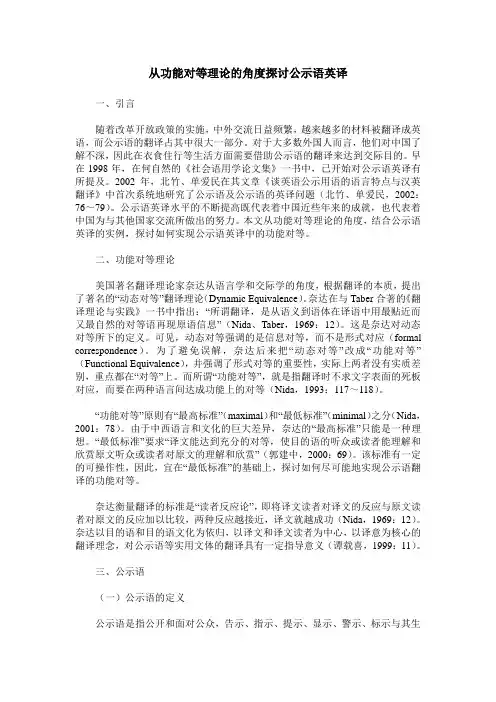
从功能对等理论的角度探讨公示语英译一、引言随着改革开放政策的实施,中外交流日益频繁,越来越多的材料被翻译成英语,而公示语的翻译占其中很大一部分。
对于大多数外国人而言,他们对中国了解不深,因此在衣食住行等生活方面需要借助公示语的翻译来达到交际目的。
早在1998年,在何自然的《社会语用学论文集》一书中,已开始对公示语英译有所提及。
2002年,北竹、单爱民在其文章《谈英语公示用语的语言特点与汉英翻译》中首次系统地研究了公示语及公示语的英译问题(北竹、单爱民,2002:76~79)。
公示语英译水平的不断提高既代表着中国近些年来的成就,也代表着中国为与其他国家交流所做出的努力。
本文从功能对等理论的角度,结合公示语英译的实例,探讨如何实现公示语英译中的功能对等。
二、功能对等理论美国著名翻译理论家奈达从语言学和交际学的角度,根据翻译的本质,提出了著名的“动态对等”翻译理论(Dynamic Equivalence)。
奈达在与Taber合著的《翻译理论与实践》一书中指出:“所谓翻译,是从语义到语体在译语中用最贴近而又最自然的对等语再现原语信息”(Nida、Taber,1969:12)。
这是奈达对动态对等所下的定义。
可见,动态对等强调的是信息对等,而不是形式对应(formal correspondence)。
为了避免误解,奈达后来把“动态对等”改成“功能对等”(Functional Equivalence),并强调了形式对等的重要性,实际上两者没有实质差别,重点都在“对等”上。
而所谓“功能对等”,就是指翻译时不求文字表面的死板对应,而要在两种语言间达成功能上的对等(Nida,1993:117~118)。
“功能对等”原则有“最高标准”(maximal)和“最低标准”(minimal)之分(Nida,2001:78)。
由于中西语言和文化的巨大差异,奈达的“最高标准”只能是一种理想。
“最低标准”要求“译文能达到充分的对等,使目的语的听众或读者能理解和欣赏原文听众或读者对原文的理解和欣赏”(郭建中,2000:69)。
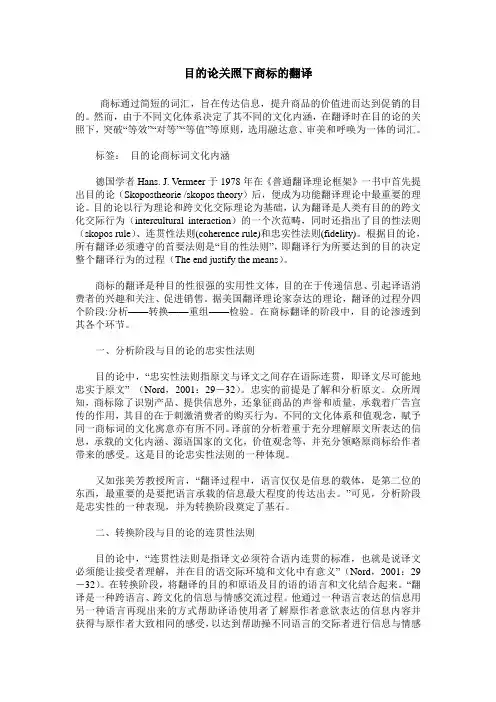
目的论关照下商标的翻译商标通过简短的词汇,旨在传达信息,提升商品的价值进而达到促销的目的。
然而,由于不同文化体系决定了其不同的文化内涵,在翻译时在目的论的关照下,突破“等效”“对等”“等值”等原则,选用融达意、审美和呼唤为一体的词汇。
标签:目的论商标词文化内涵德国学者Hans. J. Vermeer于1978年在《普通翻译理论框架》一书中首先提出目的论(Skopostheorie /skopos theory)后,便成为功能翻译理论中最重要的理论。
目的论以行为理论和跨文化交际理论为基础,认为翻译是人类有目的的跨文化交际行为(intercultural interaction)的一个次范畴,同时还指出了目的性法则(skopos rule)、连贯性法则(coherence rule)和忠实性法则(fidelity)。
根据目的论,所有翻译必须遵守的首要法则是“目的性法则”,即翻译行为所要达到的目的决定整个翻译行为的过程(The end justify the means)。
商标的翻译是种目的性很强的实用性文体,目的在于传递信息、引起译语消费者的兴趣和关注、促进销售。
据美国翻译理论家奈达的理论,翻译的过程分四个阶段:分析——转换——重组——检验。
在商标翻译的阶段中,目的论渗透到其各个环节。
一、分析阶段与目的论的忠实性法则目的论中,“忠实性法则指原文与译文之间存在语际连贯,即译文尽可能地忠实于原文” (Nord,2001:29-32)。
忠实的前提是了解和分析原文。
众所周知,商标除了识别产品、提供信息外,还象征商品的声誉和质量,承载着广告宣传的作用,其目的在于刺激消费者的购买行为。
不同的文化体系和值观念,赋予同一商标词的文化寓意亦有所不同。
译前的分析着重于充分理解原文所表达的信息,承载的文化内涵、源语国家的文化,价值观念等,并充分领略原商标给作者带来的感受。
这是目的论忠实性法则的一种体现。
又如张美芳教授所言,“翻译过程中,语言仅仅是信息的载体,是第二位的东西,最重要的是要把语言承载的信息最大程度的传达出去。
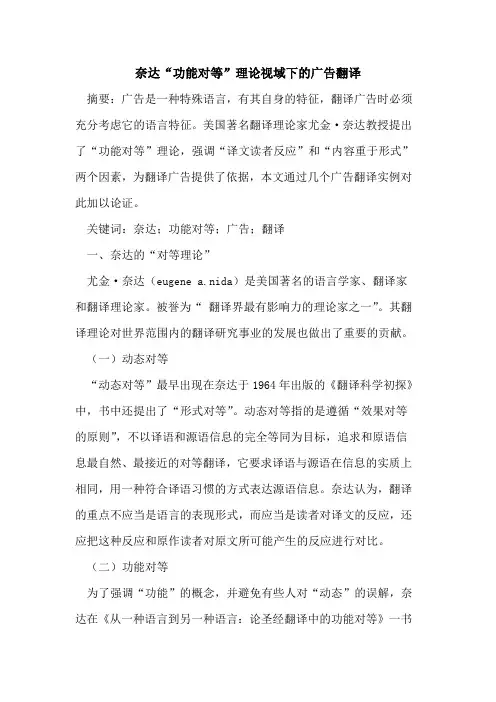
奈达“功能对等”理论视域下的广告翻译摘要:广告是一种特殊语言,有其自身的特征,翻译广告时必须充分考虑它的语言特征。
美国著名翻译理论家尤金·奈达教授提出了“功能对等”理论,强调“译文读者反应”和“内容重于形式”两个因素,为翻译广告提供了依据,本文通过几个广告翻译实例对此加以论证。
关键词:奈达;功能对等;广告;翻译一、奈达的“对等理论”尤金·奈达(eugene a.nida)是美国著名的语言学家、翻译家和翻译理论家。
被誉为“翻译界最有影响力的理论家之一”。
其翻译理论对世界范围内的翻译研究事业的发展也做出了重要的贡献。
(一)动态对等“动态对等”最早出现在奈达于1964年出版的《翻译科学初探》中,书中还提出了“形式对等”。
动态对等指的是遵循“效果对等的原则”,不以译语和源语信息的完全等同为目标,追求和原语信息最自然、最接近的对等翻译,它要求译语与源语在信息的实质上相同,用一种符合译语习惯的方式表达源语信息。
奈达认为,翻译的重点不应当是语言的表现形式,而应当是读者对译文的反应,还应把这种反应和原作读者对原文所可能产生的反应进行对比。
(二)功能对等为了强调“功能”的概念,并避免有些人对“动态”的误解,奈达在《从一种语言到另一种语言:论圣经翻译中的功能对等》一书中,在“动态对等”的基础上,他又提出了“功能对等”理论,并将其分为“最低层次对等”(minimal equivalence)和“最高层次对等”(maximum equivalence)。
奈达认为,最低层次对等是指“目的语读者能理解和欣赏原文读者对原文的理解和欣赏”,最高层次对等是指“目的语读者在理解和欣赏译文时所作出的反应,与原文读者对原文的理解和欣赏所作出的反应基本一致”(奈达,2001:87)。
“功能对等”不是语言的对等,而是语言功能的对等,是读者心理反应的对等。
译文在译文读者心中的反应是否和原文在原文读者心中的反应相似,才是奈达所关注的。
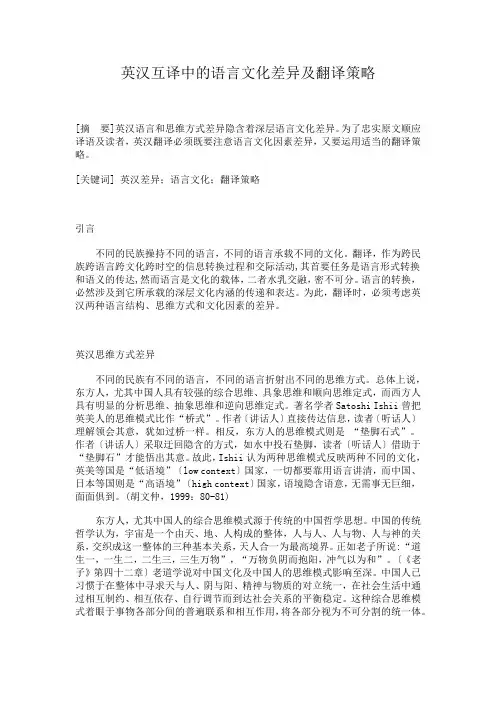
英汉互译中的语言文化差异及翻译策略[摘要]英汉语言和思维方式差异隐含着深层语言文化差异。
为了忠实原文顺应译语及读者,英汉翻译必须既要注意语言文化因素差异,又要运用适当的翻译策略。
[关键词] 英汉差异;语言文化;翻译策略引言不同的民族操持不同的语言,不同的语言承载不同的文化。
翻译,作为跨民族跨语言跨文化跨时空的信息转换过程和交际活动,其首要任务是语言形式转换和语义的传达,然而语言是文化的载体,二者水乳交融,密不可分。
语言的转换,必然涉及到它所承载的深层文化内涵的传递和表达。
为此,翻译时,必须考虑英汉两种语言结构、思维方式和文化因素的差异。
英汉思维方式差异不同的民族有不同的语言,不同的语言折射出不同的思维方式。
总体上说,东方人,尤其中国人具有较强的综合思维、具象思维和顺向思维定式,而西方人具有明显的分析思维、抽象思维和逆向思维定式。
著名学者Satoshi Ishii曾把英美人的思维模式比作“桥式”。
作者〔讲话人〕直接传达信息,读者〔听话人〕理解领会其意,犹如过桥一样。
相反,东方人的思维模式则是“垫脚石式”。
作者〔讲话人〕采取迂回隐含的方式,如水中投石垫脚,读者〔听话人〕借助于“垫脚石”才能悟出其意。
故此,Ishii认为两种思维模式反映两种不同的文化,英美等国是“低语境”〔low context〕国家,一切都要靠用语言讲清,而中国、日本等国则是“高语境”〔high context〕国家,语境隐含语意,无需事无巨细,面面俱到。
(胡文仲,1999:80-81)东方人,尤其中国人的综合思维模式源于传统的中国哲学思想。
中国的传统哲学认为,宇宙是一个由天、地、人构成的整体,人与人、人与物、人与神的关系,交织成这一整体的三种基本关系,天人合一为最高境界。
正如老子所说:“道生一,一生二,二生三,三生万物”,“万物负阴而抱阳,冲气以为和”。
〔《老子》第四十二章〕老道学说对中国文化及中国人的思维模式影响至深。
中国人已习惯于在整体中寻求天与人、阴与阳、精神与物质的对立统一,在社会生活中通过相互制约、相互依存、自行调节而到达社会关系的平衡稳定。

2018年40期总第428期ENGLISH ON CAMPUS奈达功能对等视角下的体育品牌商标翻译文/褚骞【摘要】本研究从奈达功能对等的角度入手探讨体育品牌商标的翻译,讨论在其指导下如何运用翻译方法使译文与原文达到对等性。
现今,中国与世界各国的贸易交往日趋频繁。
为了帮助体育产品在国内外市场上迅速被接受,首要的工作之一就是打造知名品牌。
一个完美的体育品牌及其译名能为产品创造极大的利润,像“Nike”耐克这样的商标译名已被公认为体育品牌翻译的典范。
因此,商标的翻译显得越来越重要。
美国翻译理论家奈达的功能对等理论自问世以来,在国内外翻译界都产生了深远的影响。
【关键词】功能对等;体育品牌;翻译【作者简介】褚骞(1992-),男,俄罗斯族,山东龙口人,硕士在读,西南民族大学, 研究方向:英语翻译口译。
IntroductionWith the rapid development of international trade and economic globalization, brand name translation has become an essential market strategy to most business. The great success of London Olympic Games and people’s love in sports make the sport industry has a promising future. In order to promote the sales of products to foreign markets, brand name translation is gaining greater and greater importance. This paper, by giving a detailed account of translating sport brand names between Chinese and English, attempts to study the practice and theory of translating sport brand names from a cultural, psychological and marketing point of view, under the guidance of functional equivalence theory.In this thesis, the writer hopes to increase translator’s understanding of the brand name translation and to discuss on a theoretical base that can help them make decisions when translating brand name into another culture.The significance of the study mainly lies in several aspects. Firstly, the writer advocates that the theory should combine with practice and guide practice instead of talking about the theory only. Secondly, the writer introduces Nida’s Functional Equivalence Theory and analyzes the methods of applying this theory to brand name translation by examples.1. Literature ReviewBrand name translation plays a vital role in establishing the international brand image of a company. In recent years, brand name translation has received wide attention. By reading the related documents available and surfing the websites of international advertising companies, name companies, etc, the author finds that from the 1990s, many scholars both at home and abroad have devoted themselves to brand name translation under the guidance of different theories. The following are some examples: While, Li Zhiyuan explored the approaches for brand name translation through analyzing the brand name formations and its characteristics, he concluded that when brand names can find the equivalent word in target language, communication can bring the vocative effect to the brand name translation.2. Functional Equivalence TheoryEugene A. Nida is a distinguished American translation theorist as well as linguist. His translation theory has exerted a tremendous influence on translation studies in western countries. It shows that he has made great contributions to the field of translation studies. His influences go beyond the translation of the Bible and the borders of the nations. His theory has guided translation practice of various kinds, not only the U. S, but also in many other parts of the world. He himself has also become one of the most frequently quoted authors in the field of translation.3. A Brief Introduction of Brand NamesSince “Brand name translation is in connection with both the source culture and the target culture” (O’Guinn, Allen and Semenik 22), to get the target brand name coherent not only with the source culture but also with the target culture, the translator should know something about the features of the brand names. Almost all the successful brand names have the following features, which should be taken into consideration in translation.a. Brevity“When choosing a brand name for its products, a company wants a name that will be easily remembered, recognized by the customer”, and “short brand names have been found to have greater impact in customers than long ones” (Mason, etal. 163). Brevity means that the brand name should be kept short and sweet in the process of naming and translating.It should be also kept in brand name translating. In order to achieve brevity, certain syllables of less importance have to be omitted in translating longer brand names. b. Novelty2152162018年40期总第428期ENGLISH ON CAMPUSA brand name should be as novel and unconventional as possible in wording, pronunciation, meaning and otheraspects, so as to arouse the interest of the customers and leave a deep impression on them. The brand designers try every means to make the brand name unique by employing figures of speech, adding humorous element, or coiningnew words. The novelty of the brand name should help to strengthen the merits of the product, and thus help the readers to understand the nature of the product, and thus help the readers to understand the nature of the product.c. ReadabilityReadability indicates that a brand name should be easyto read and not likely be mispronounced or misunderstood. A brand name is, after all, for the eyes of the broad masses of consumers. If uncommon characters are used, undereducated consumers will fail to recognize them or will mispronounce them, which will inevitably impair the effectiveness of thebrand name in use.4. Functional Equivalence in the Translation of Sport Brand Names4.1 The Factors to be considered in the Translation of Sport Brand NamesGlobal sport branding is complicated by the diversityof languages, nationalism, product attributes, and culture. Developing a world brand is not an easy translation exercise, as meanings vary greatly across norms, attitudes, beliefs and cultures, so all factors should be taken into consideration toget a good translation from English to Chinese, and vice versa.4.2 Cultural Factors of the Target ConsumersCulture is an extremely complex concept and anenormous subject. It embraces almost everything in the world, material and spiritual. It includes: all the products of manufacture, various systems and the theories that support them, such as social systems, religious systems, ritual systems, educational systems, kinship systems and language, people’s mentality and behaviors, their thought patterns, beliefs, conceptions of value, aesthetic tastes, etc.Translating means “to express in another languageor in simpler words”. (Oxford Dictionary, 1997) In fact, the translation of one language into another is far more complex than this definition.(1) Catering; to Target Consumers’ AppetiteThe world well-known sport brand Nike is an goodexample. The word “nike” means victory and propitious in its English origin, and is translated into“耐克”in Chinese.The brand name are loved by Chinese people, the word “耐”reflects the products are durable and “克” meansdefeat the enemy and win victory. In this way, the targetreceptors feel the same way toward the name with the original readers, and the selling is good, so it is a successful translation.(2) Avoiding Target Consumers’ TaboosIn Chinese tradition, many brand names are named afterfowls and animals. But different nations hold completely different feelings of likes and dislikes toward the same fowls and animals. For example, in Chinese culture,“喜鹊”is the “reporter of spring”, the “messenger of good luck”; while in English cultures, magpie reminds people of nagging and tortuous, if it is a word for word translation in the brandnames, the meaning of brand names is lost. (Guo Shangxing, 1995:30)The above instances show that the relationship betweenculture and communication is complex, and good translation of brand names should always take culture factors intocautious consideration. Culture influences communication, and vice versa.4.3 Translation Strategy of Sport Brand Names 4.3.1 TransliterationTransliteration method is an ideal method in thetranslation of sporting brand names because it not only reproduces the beauty of pronunciation of the original name in form, but also reflects the characteristics of the product in its content. Transliteration means to select the propitious words which are homophones so that it makes the translation approach to the original name in pronunciation but also has of commendatory in the meaning which can satisfy consumers’ psychology. Therefore, more and more translators adopt transliteration method in the translation of cosmetic brand names. Let’s look at an example: the translation of “Nike”is a successful case. It is translated into “耐克”. Fromthe perspective of transliteration, “耐克”is close to the pronunciation of the original name. The two words are lovedby Chinese people, the word “耐”reflects the products are durable and “克” means defeat the enemy and win victory.“Adidas, Kappa, Giant, Anta, Li Ning” are translated into “阿迪达斯、卡帕、捷安特、安踏和李宁”. Others like “Peak, Columbia, Star, Wilson, Head, Avia and Voit are translated into “匹克、哥伦比亚、世达、海德、爱维亚和沃特”. “八哥” is a Chinese sport brand, its English translation is “Bage” which means brave age. These translations not only successfully conveys the beauty of pronunciation of the original name, but also vividly and lively transfers the sports features of the brand and arouses forceful imaginations so that it can stimulate purchasing desires of consumers and achieve the translation purpose.4.3.2 Literal TranslationLiteral translation means to translate according to its2018年40期总第428期ENGLISH ON CAMPUSliteral meaning. It maintains the referential meaning of the words and makes the content matches up the form under the condition of not violating the culture traditions. The number of adopting literal translation to translate the sporting brand names is rare. Only when the original name is special, meaningful and is welcomed by consumers, literal translation is employed. For example, “Jordan” is translated into “乔丹”by using literal translation, since Michal Jordan is a famous basketball player in the world. “Double Star” is translated into “双星”literally. The same goes to “Double fish双鱼” “Double Happiness 红双喜” “Victor 胜利” “Butterfly 蝴蝶” “Train火车头” “Prince 王子” and “Savage 野人”. Thus, the skillful use of literal translation can bring better imaginations and perfect feelings.4.3.3The Combination of Transliteration and Literal TranslationSince many transliteration or liberal translation cannot do the job alone, we can use the combination of transliteration and liberal translation to translate sporting brand names. A good translation of a brand name should not only be similar to the original sound but also reflect the connotation of the original. The combination of transliteration and liberal translation may achieve dual purpose, as the message of the brand name will be more vividly reflected so that it will be more impressive to guide consumption. And by using this method, it can achieve a closer effect to Nida’s functional equivalence since a maximal, ideal definition could be stated as “The readers of a translated text should be able to understand and appreciate it in essentially the same manner as the original readers did. Many cases choose this method. Such as “Reebok”, which translated into “锐步”; “Puma” is called by “彪马”; “Lotto”, its Chinese version is “乐图”; “Decathlon” is translated into “迪卡侬”. Others like “Deerway”, “Warrior”, ‘Teloon”, “Mizuno”, “Toread” are named by “德尔惠”, “回力”, “天龙”, “美津浓”, “探路者”. In same circumstances, the method of the combination of transliteration and liberal translation can be adopted to achieve the best effect in the sporting brand name translation.5. ConclusionA tentative study has been made in this thesis on the topic of sport band names translation, which is a relatively new genre in the field of translation. Actually it is a science as well as an art. It is a comprehensive process, which covers cultures, consumer’s psychology, commercials and translation studies. Sport brand name translation has its own unique function and purpose, which is to attract attention, arouse interest, stimulate desire and get action. Undoubtedly, the application of functional equivalence theory to sport brand name translation can help to choose proper strategies on different occasions. Based on functional equivalence theory, the commonly use translation strategies for sport brand name translation can be listed as follows: literal translation, transliteration and the combination of transliteration. In sport brand name translation, the translator should cautiously and flexibly adopt these translation strategies according to different situation. Because none of these methods almighty in all situations.In a word, sport brand name translation is a complicated work which involves linguistics, translation theory, marketing, psychology and culture, etc. As economic globalization keeps on developing, further and detailed studies on sport brand name translation form the perspective of the Nida’s Functional Equivalence Theory need to be carried on to meet the new challenges in this field.参考文献:[1]陈福宇.从消费心理学的角度论商标翻译中的功能理论[D].四川师范大学,2004.[2]郭尚兴.论商标的翻译与确立[J].中国科技翻译,1995(4):20-22.[3]Aker,David A. Managing Brand Equity[M].The Free Press,1991.[4]Anthony Pecotich,F.C.Hong and Clifford J.Shultz II.Brand Name Translation:Language Constraints, Product Attributes,and Consumer Perceptions in East and Southeast Asia[J].Journal of International Marketing,1998.[5]AS Hornby.Oxford Dictionary[M].Oxford:Oxford University Press,1997.[6]Dong L C.Brand name translation model:A case analysis of US brands in China[J].Journal of Brand Management,2001,9,2:99-115. [7]Jan de Warrd & Eugene A.Nida. From One Language to Another [M].New York:Thomas Nelson Publishers,1986.[8]Stephen Bullon. Longman Dictionary of Contemporary English[J]. Oxford:Longman,2006.[9]Mason.E.Ralph,Rath,Patricia and Husted,W.Stewart.Marketing Practices and Principles[M].New York:McGraw-Hill,1986.[10]Nida,Eurgene A. Toward a Science of Translating:with Special Reference to Principles and Procedures Involved in Bible Translating [M].Leiden:E.J.Brill,1964.[11]Nida,Eugene A.&Charles R.Taber.The Theory and Practice of Translation[M].Leiden:E.J.Brill,1969.[12]O’Guinn,Thomas C.Allen,Chris T and Semenik,Richard J[J]. Advertising and Integrated.[13]Brand Promotion.South-Weatern[M].Division of Thomason Learning,2011.217。
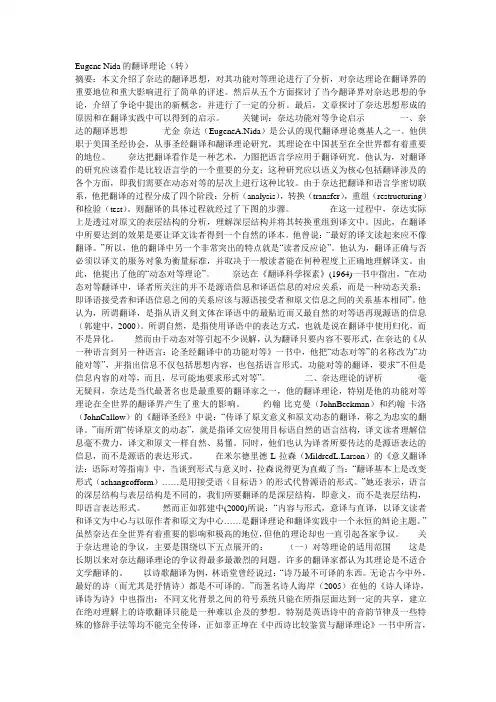
Eugene Nida的翻译理论(转)摘要:本文介绍了奈达的翻译思想,对其功能对等理论进行了分析,对奈达理论在翻译界的重要地位和重大影响进行了简单的评述。
然后从五个方面探讨了当今翻译界对奈达思想的争论,介绍了争论中提出的新概念,并进行了一定的分析。
最后,文章探讨了奈达思想形成的原因和在翻译实践中可以得到的启示。
关键词:奈达功能对等争论启示一、奈达的翻译思想尤金·奈达(EugeneA.Nida)是公认的现代翻译理论奠基人之一。
他供职于美国圣经协会,从事圣经翻译和翻译理论研究,其理论在中国甚至在全世界都有着重要的地位。
奈达把翻译看作是一种艺术,力图把语言学应用于翻译研究。
他认为,对翻译的研究应该看作是比较语言学的一个重要的分支;这种研究应以语义为核心包括翻译涉及的各个方面,即我们需要在动态对等的层次上进行这种比较。
由于奈达把翻译和语言学密切联系,他把翻译的过程分成了四个阶段:分析(analysis),转换(transfer),重组(restructuring)和检验(test)。
则翻译的具体过程就经过了下图的步骤。
在这一过程中,奈达实际上是透过对原文的表层结构的分析,理解深层结构并将其转换重组到译文中。
因此,在翻译中所要达到的效果是要让译文读者得到一个自然的译本。
他曾说:“最好的译文读起来应不像翻译。
”所以,他的翻译中另一个非常突出的特点就是“读者反应论”。
他认为,翻译正确与否必须以译文的服务对象为衡量标准,并取决于一般读者能在何种程度上正确地理解译文。
由此,他提出了他的“动态对等理论”。
奈达在《翻译科学探素》(1964)一书中指出,“在动态对等翻译中,译者所关注的并不是源语信息和译语信息的对应关系,而是一种动态关系;即译语接受者和译语信息之间的关系应该与源语接受者和原文信息之间的关系基本相同”。
他认为,所谓翻译,是指从语义到文体在译语中的最贴近而又最自然的对等语再现源语的信息(郭建中,2000)。
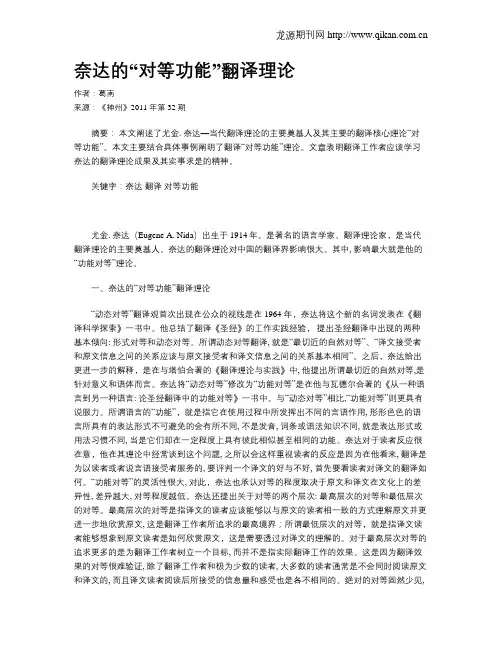
奈达的“对等功能”翻译理论作者:葛南来源:《神州》2011年第32期摘要:本文阐述了尤金. 奈达—当代翻译理论的主要奠基人及其主要的翻译核心理论“对等功能”。
本文主要结合具体事例阐明了翻译“对等功能”理论。
文章表明翻译工作者应该学习奈达的翻译理论成果及其实事求是的精神。
关键字:奈达翻译对等功能尤金. 奈达(Eugene A. Nida)出生于1914年。
是著名的语言学家、翻译理论家,是当代翻译理论的主要奠基人。
奈达的翻译理论对中国的翻译界影响很大。
其中, 影响最大就是他的“功能对等”理论。
一、奈达的“对等功能”翻译理论“动态对等”翻译观首次出现在公众的视线是在1964 年,奈达将这个新的名词发表在《翻译科学探索》一书中。
他总结了翻译《圣经》的工作实践经验,提出圣经翻译中出现的两种基本倾向: 形式对等和动态对等。
所谓动态对等翻译, 就是“最切近的自然对等”、“译文接受者和原文信息之间的关系应该与原文接受者和译文信息之间的关系基本相同”。
之后,奈达给出更进一步的解释,是在与塔伯合著的《翻译理论与实践》中, 他提出所谓最切近的自然对等,是针对意义和语体而言。
奈达将“动态对等”修改为“功能对等”是在他与瓦德尔合著的《从一种语言到另一种语言: 论圣经翻译中的功能对等》一书中。
与“动态对等”相比,“功能对等”则更具有说服力。
所谓语言的“功能”,就是指它在使用过程中所发挥出不同的言语作用, 形形色色的语言所具有的表达形式不可避免的会有所不同, 不是发音, 词条或语法知识不同, 就是表达形式或用法习惯不同, 当是它们却在一定程度上具有彼此相似甚至相同的功能。
奈达对于读者反应很在意,他在其理论中经常谈到这个问题, 之所以会这样重视读者的反应是因为在他看来, 翻译是为以读者或者说言语接受者服务的, 要评判一个译文的好与不好, 首先要看读者对译文的翻译如何。
“功能对等”的灵活性很大, 对此,奈达也承认对等的程度取决于原文和译文在文化上的差异性, 差异越大, 对等程度越低。
功能对等理论视角下商标名称的翻译研究Translation Strategies of Brand Name from the Perspective of FunctionalEquivalenceAbstractBrand name is important for the success of a product. A good brand name can bring endless profits and a bad one can only lead to the collapse of the manufacturer. In a time where international trade and exchange are more and more frequent, and international competitions are more and more vehement. An entrepreneur that struggles to make profits must be care of the brand name translation. With the brand name gaining its weight in the international trade, the study of translation of the brand name also becomes a major concern of the theorist and translation practitioners.The study of the translation of brand name in this thesis is made under the light of functional equivalence theory proposed by Nida. This is because that one of the major function of brand name is to persuade the consumers to trust the high quality of the product and take actions. This is in line with the essence of the functional equivalence theory, which take the relationship between the consumer and the translation. This thesis will discuss the basic rules and principle of brand names and then analyze the translation methods of brand names in the light of functional equivalence theory and finally some sound conclusions are drawn. The findings show that the translation of brand names should take the functions of the brand name into consideration and combines with functional equivalence theory so that an ideal translation can be obtained.Key words: brand name, translation, functional equivalence摘要商标名称对一个产品的成功至关重要。
商标文化翻译的重要性发布:npking | 发布时间: 2011年4月2日随着经济全球化进程的加快,国际贸易成为促进世界各国经济发展的重要动力,商标翻译则对商品在海外市场的销售起着举足轻重的作用。
商标翻译是一种跨文化交际形式,涉及到价值观念、文化心理、审美情趣、宗教习俗等诸多因素。
商标翻译不仅是一种语言翻译,更是一种文化翻译。
只有跨越了目标语的文化障碍,成功地处理跨文化交际中的文化顺应,才能译出符合消费者审美情趣和心理需求的商标,以期使品牌在目标市场中能够获得文化认同,从而取得成功。
一、商标文化翻译的重要性语言是文化的载体。
形式上在商标的翻译者和接受者之间传递的是商品信息,实质上传递的是一种文化信息。
正如Nida E.A.(1993)指出:“对于真正成功的翻译而言,熟悉两种文化甚至比掌握两种语言更重要,因为词语只有在其作用的文化背景中才具有意义。
”翻译是实现商标国际化最根本的途径,商标的文化内涵和跨文化交际的特征又使这种翻译与文化密不可分,其翻译必须符合目的语文化的接受要求,符合该文化语境中受众的表达习惯,符合其审美心理。
二、商标翻译中的文化顺应顺应理论最早由 Jef Verschueren(2000)提出。
根据这一理论,就商标翻译而言:商标翻译是一种跨文化交际形式,既是两种语言又是两种文化之间的交流,在这一过程中,既要进行语言顺应又要进行文化顺应,而文化顺应尤为重要。
换言之,对商标的翻译应要求译文和原文既有大致相同的宣传功能,又有非常接近的文化信息传递功能和移情感召功能。
1、顺应民族文化心理特征和价值观各民族文化心理特征不同,从而产生不同的价值观念、联想意义和消费心理。
国外许多产品商标的翻译就是结合中国文化和汉语语言,译出既符合中国人的心理习惯又很有东方文化情趣的汉语商标词。
CocaCola译名“可口可乐”,除了顾及音译外还传达出美味可口,饮后快乐的寓意。
瑞典手机品牌“Ericson”译名“爱立信”,简洁明快,并有“真诚可信”之内涵,深入人心。
商标翻译中的动态对等沈惠娟① 余孝平 龚 丹(景德镇陶瓷学院外语系,江西景德镇 333001)摘 要:随着商品经济的迅猛发展,商标翻译在帮助商品进入国际市场、打开销路中起着越来越重要的作用。
本文基于尤金・奈达“动态对等”的翻译理论,阐述翻译商标时应考虑译文读者的文化差异、心理接受、审美情趣,使译文读者在阅读商标译文时能产生与原文读者阅读原语商标时基本相同的反应。
关键词:动态对等;商标翻译;文化差异中图分类号:H315.9 文献标识码:B 文章编号:1008-8458(2007)02-0103-030 引 言随着全球经济一体化的不断发展,越来越多的外国商品涌入中国市场,同时中国商品也不断进入国际市场参与竞争。
这种竞争不仅是商品的竞争、服务的竞争,更是企业形象的竞争、品牌的竞争。
商标是制造商或商人为了使人认明自己的商品或劳务,从而使它们与其它竞争者的商品区别开来而使用的标识。
在现代市场经济中,商标能否吸引消费者,会直接造成商品销售业绩上的巨额差异,所以商家总是设法从各个角度来挖掘品牌名称的商业魅力。
许多国际著名商标已经成为企业的无形资产和巨大财富。
商品如果想成功地进入国际市场,吸引消费者,它不仅需要成功的商标,而且需要成功的商标翻译。
从某种意义上说,商标的翻译是一次再创造,在翻译过程中,不仅涉及语言因素,同时还涉及文化差异、心理接受能力、审美情趣等多方面的因素。
成功的翻译需要有相关的翻译理论加以指导,使译文读者在阅读商标译文时能产生与原文读者阅读原语商标时基本相同的反应。
美国著名的翻译理论家尤金・奈达的“动态对等”翻译理论对商标的翻译就有很好的指导作用。
1 尤金・奈达的动态对等理论简述尤金・奈达(Eugene N ida)是著名的美国语言学家,是西方当代翻译理论研究领域中的杰出代表之一。
他在二十世纪六十年代提出了著名的“动态对等”翻译理论观点。
所谓“动态对等”,就是指译文接受者对译文的反应要基本等同于原文接受者对原文的反应(The res ponse of the target reader reading the translati on should r oughly be the sa me t o the reader reading the original text)。
195《商场现代化》2007年11月(下旬刊)总第522期不同理解上。
例如:我国商家都喜欢用“8”来给商品命名,取“8”的谐音“发”的意思;在日语中,“8事业越来越旺、人生道路越来越宽的含义;但在英语中,具有相应意义的数字是“7”。
因此英译商标时要充分考虑到商品所销国家和地区的文化、历史和风俗。
在汉英商标翻译中,应尽量避免带有文化禁忌色彩的词语或现象,避免由于译入语中指称意义和语用意义脱节引起不好的联想;充分考虑到译入语顾客的接受心理。
如中国人含蓄庄重,因此英文商标“Kiss”唇膏译为“奇士美”比译为“吻我”更能让人接受。
3.文化特色的原则。
语言反映一个民族的特征,它不仅包含生活方式和思维方式。
语言的适用性以及使用范围受到多种因素的影响,历史的、经济的、政治的等等。
随着中国国际地位的提高,本身通行于许多华人世界的汉语也越来越受到更广泛的关注。
通行世界的英语也日益受到汉语的影响。
总部位于美国的全球语言监测机构曾指出,2006年登记的英语新词共2万个,其中两成为“中式英语”。
另据统计,牛津英语词典中以汉语为来源这说明具有中国特色的词汇是可以进入英语,向世界展示中国的特色。
如奥运会的吉祥物“福娃”被翻译成“fuwa”,现在已被一些商家用来作为商品的商标;“豆腐”是中国的传统营养食品,被译成“tofu”;功夫牌拖鞋商标的英译为“gongfu”。
4.语言简练的原则。
商标的翻译在遵循上述原则的同时,还义的完美统一,以便符合人们的审美情趣和心理,便于在消费者心中定位。
如把“美晨”牙膏译成mason要比Beautiful&Morning简洁明了,把“美加静”牙膏译成MAXAM比译成Beautiful&clean要符合人民的审美情趣。
在翻译时,可将原名的多音节减为两字或三字的商标。
如McDonald译成“麦当劳”;Aquafresh牙膏.等等。
让消费者喜欢、接受并购买产品。
所以在翻译商标时,翻译工作者应投消费者之所好。
论“功能对等”理论对翻译实践的指导本文以尤金·奈达的“功能对等”理论为基础,通过概述该理论的内涵和特征,归纳出该理论指导翻译实践的四个标准:传达原作信息;再现原作的风格和精神;语言自然顺畅,符合译语规范和表达习惯;读者反应近似。
本文以《英译中国现代散文选(一)》为语料,检测“功能对等”在翻译实践中的有效度。
标签:尤金·奈达功能对等指导标准翻译实践一、引言在中国,尤金·奈达的翻译理论是当代西方翻译理论中介绍得最早、最多、影响最大的理论。
“功能对等”理论是奈达翻译理论的核心,自20世纪80年代初被介绍到中国以来,在中国翻译界产生了深远的影响。
奈达对世界翻译研究事业的发展有着重要的贡献,正如克里斯蒂安·巴柳(Christian Balliu)所说:“奈达的著作,开创了翻译理论的新时代”(郭建中,1999)。
本文将通过概述“功能对等”理论的内涵和特征,并结合一些翻译实例,力求在翻译实践中正确运用该理论。
二、奈达的对等理论概述1964年,奈达在其著作《翻译科学初探》中提出了“形式对等(formal equivalence)”和“动态对等(dynamic equivalence)”概念。
根据奈达的观点,各种语言在形式和内容上都普遍存在很大的差异,“形式对等”概念的应用范围较为有限。
奈达特别强调后者,认为“动态对等”的概念反映了翻译的本质:“所谓翻译,是在译语中用最切近而又最自然的对等语再现源语的信息,首先是意义,其次是文体。
”(Nida & Taber,1969)在这一定义中,“切近”是指“切近源语的信息”;“自然”是指译语中的表达方式;“对等”则把上述两者结合起来,是对等语(equivalent),而不是同一语(identity)(郭建中,1999)。
很明显,该定义强调的是信息对等,而非形式对应(formal correspondence)。
奈达在“动态对等”中突出了“内容为主,形式为次”的思想,但这一思想引起了不少误解。